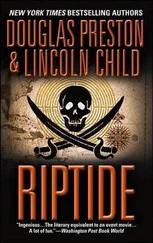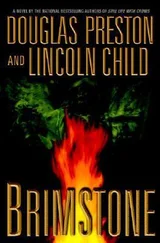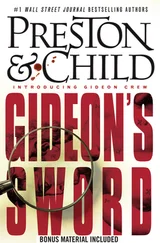He ducked back out into the passage and continued on until he came to a dogleg, beyond which a group of German soldiers was hunkered down, apparently pinned by fire from the Brazilians. The narrow tunnels, heavy stone walls, and endless alcoves and hiding places helped defray, at least to a degree, the Brazilians’ severe disadvantage in numbers. Listening intently, Pendergast surmised that the Brazilian soldiers must be in a highly defensible redoubt inside the wall itself, fighting hard but hemmed in on all sides. They were doomed unless they could break free.
Pendergast crept around the corner, waited for a loud explosion, and then—using the sound as cover—dropped one of the German soldiers with a shot to the femoral artery in the thigh, where the direction his shot had come from would not be as obvious. He waited again, took another opportunity to drop a second German. It was as he had hoped: the soldiers, not realizing they were taking fire from behind, retreated toward him in some confusion, thinking instead they were being exposed to fire from an unknown direction ahead. Pendergast quickly fell back into the lab to let them pass. He then moved out—now in front of the retreating group—and, rifling one of the bodies he had shot, retrieved several grenades and two full Sturmgewehr magazines, all the while taking periodic cover as he was fired on by the panicked Brazilian troops.
Now rearmed, Pendergast made a loop back to the lab, wired all the grenades together, and tied a breakaway knot around the spoon levers. Next, he searched around for a thin wire, and—finding one—pulled out the pins from all the grenades. With infinite care, he moved back into the tunnel, listening for the pauses between explosions and gunfire. At the correct moment, he sprinted down the tunnel, stopping at a point where the roof was webbed with cracks from the resurgent ground. Rolling a gurney out of an adjacent lab, he climbed onto it, affixed the bundle of grenades to the ceiling with a chock, and unrolled the thin wire he’d found in the lab from the breakaway knot holding the grenade levers. He shoved the gurney back into the lab and crouched in the doorway, listening again.
After a moment he let fly with several massive bursts from his gun. “ Sie sind hier! ” he shouted. “ Schnell! Hurry, over here!”
He followed this cry with more bursts of gunfire. “Hurry!”
The German soldiers fell back rapidly toward him, crouching and firing as they retreated, crab-like.
Pendergast let loose another burst of automatic fire, then cried for help. “ Hilfe! Hilfe! ”
As they approached, Pendergast jerked the wire, releasing the spoon levers on the cluster of grenades—and then ducked into the lab, shutting the steel door behind him. A moment later, a massive explosion sounded in the hallway. The tiny window in the door blew out; the door itself was ripped from its hinges and flung into the room. Pendergast, crouching against the rear wall, stood up and dashed through the doorway into choking stone dust and plaster, running amid falling blocks as the tunnel partially unraveled and began to cave in around him. Still in choking dust, with visibility zero, he came up to the colonel’s redoubt.
“Colonel, it’s Pendergast!” he cried in English and then in Portuguese. “ Me ajude! ” And then: “Follow me—we have only a moment!”
He turned and ran back into the blinding dust, the colonel and his four remaining soldiers following.

74
PAST THE CAVE-IN, THE TUNNEL RAN IN A BROAD CURVE around the inside of the fortress’s curtain wall, laboratories on the left, the massive wall itself to the right. It was the major route of movement along this lower level of the fortress: a dangerous place to be. The key, Pendergast decided, would be to go deeper still, where they might be able to escape into the labyrinth of underground passageways, dungeons, cells, and storage rooms. It was the area where Pendergast had initially been confined, but he had not explored it further during his quick reconnaissance of the fortress, believing it irrelevant.
Now it was most relevant. Indeed, it was their only chance.
Already he could hear a group of men running toward them, the clatter of rifles and the regular thud of boots echoing down the stone passageway. A laboratory door stood to their left, inset into a stone alcove, but it was locked and there was no time for Pendergast to pick it. With hand signals, he gestured for the colonel and his men to press themselves against both walls, drop to their knees, and level their rifles toward the approaching soldiers.
“Fire at will,” he said quietly. The colonel repeated the command in Portuguese.
The footsteps grew closer, echoing around the curve of the tunnel. The small band readied themselves for a point-blank ambush.
In response to a barked order, the approaching soldiers halted, just out of sight. There was a sudden silence. A moment of electric intensity ensued—and then two expertly tossed grenades came bounding off the curved wall, hitting the floor and rolling toward the Brazilians.
Taken by surprise, Pendergast and the others leapt up in a flash, turning and throwing themselves back into the alcove of the laboratory door; the grenades went off simultaneously, an enormous pressure wave in the confined space slamming them backward. One of the Brazilians, not as fast as the others, was caught in the open and vanished in a cloud of blood, flesh, bone, and dust.
Shaking his head to clear it, Pendergast fired into the enveloping dust cloud. He could hear stones falling and realized the soldiers could not advance, at least not immediately, due to the blocks tumbling from the ceiling.
“Retreat!” he said, firing another blast into the dust.
The colonel and his three remaining men ran. Pendergast continued his suppressing fire until they were safely around the curve of the wall, then he followed. A few hundred yards past, he knew, lay a lateral tunnel; he had no idea where it went and was reluctant to chance it, but they now had no choice.
“To the right!” he called ahead. “ Direita! ”
They took the tunnel, leaving the dust-choked passage behind him. There was no lighting and the colonel’s men pulled out flashlights to see what lay ahead. The tunnel was old and disused, the stones encrusted with niter, the air dead and smelling of mold and decay. They came to an ancient oaken door, banded with rotten iron, wormy with age, which fell to a single blow from a rifle barrel.
Ahead, a circular stone staircase spiraled downward into foul darkness. Behind, they could once again hear the thud of boots.
The staircase had partially collapsed, and they slithered down the broken, tumbled, slimy stones until they arrived at the lowest level of the fortress. They raced down a long tunnel that began at the base of the stairway, the sound of their pursuers not far behind.
At length the tunnel branched, then opened into a large, domed space. At the center of this space was a most unusual sight: a freestanding steel cage about fifteen feet square, securely locked. It was not fixed to the ground: rather, it was constructed around what appeared to be a deep, natural fissure in the undressed floor of the fortress’s sub-basement. Filling the fissure, and rising up to fill the cage as well, were countless boxes of weapons, grenades, shells, gunpowder casings, stamped with swastikas and warnings exhorting that the contents were very dangerous—SEHR GEFÄHRLICH. This appeared to be the central ammo dump of the fortress, located as a protective measure deep, deep within its bowels.
So their original plan, to detonate the ammo dump, would have been doomed to failure in any case: it was placed too deeply in the fortress to have blown open an entrance for the colonel and his men.
Читать дальше












